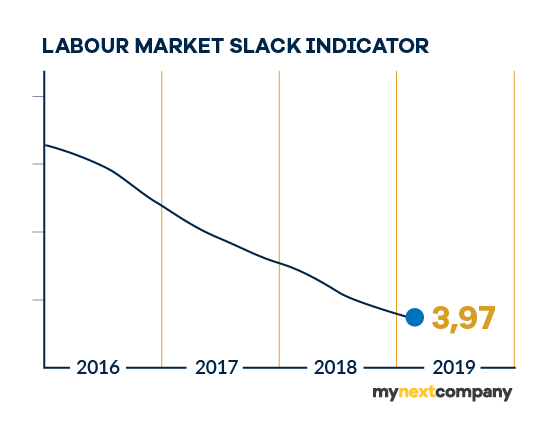
Any business owner or HR manager involved in the process of acquiring new talent for their company will certainly have noticed that recruitment is becoming increasingly difficult. This is because the job market “tightens”, which means that the labour market slack – ratio of jobseekers to vacancies – is decreasing, and it’s therefore becoming harder for employers to fill these positions.
 What’s more, the most sought-after positions are not necessarily in subject areas that young talent are most likely to choose to study at university.
What’s more, the most sought-after positions are not necessarily in subject areas that young talent are most likely to choose to study at university.
The eternal gap between supply and demand
In Flanders, for example, the subject area that continues to attract the highest number of students is business, closely followed by law. There are many factors that students consider when choosing which subject to study, and one of these relates to economic concerns. While some choose professions which are in high demand, giving themselves a vast choice of offers in the future, many select professions that are generally associated with high-income jobs.
In the academic year 2018-2019, the most popular subject areas were economics (12034 applications) and law (12134 applications). However, the sectors with the highest job vacancy rate (the highest demand for experts in this domain) are information and communication (ICT) at 6.97%, construction at 5.97% and accommodation and food service activities at 5.6%.
Employer branding: just the beginning
So, what does this all mean? Employers are fighting over a small group of experts or, metaphorically speaking, fishing in the same (nearly empty) pond. Recruitment therefore becomes an art of attracting the best candidates, and not merely through the job description and list of responsibilities and skills, but also by presenting the value the job will offer the candidate (employee value proposition).
According to a LinkedIn study,
A staggering 49% of jobseekers state that not knowing what it’s really like to work at a company is an obstacle when it comes to choosing their next career move.
However, there is a solution to this: there are platforms like CompanyMatch, that focuses on presenting company culture, and MyNextCompany, which presents each company’s value to candidates through the eyes of an outsider each time they visit a new workplace. These platforms give applicants valuable insight into their prospective employer.
However, employer branding is only half of the story. A company might have a great brand, but be less than successful in conveying this to the right group. Even with a large advertising budget, it’s possible that an ad may only reach active candidates who are proactively searching for such information, for example by checking job boards. But what about passive candidates, who are too busy or lacking the motivation to search but who might be interested in changing job if the right offer came along?
The role of inbound recruitment
Inbound recruitment is a term borrowed from marketing and is the opposite of the traditional outbound recruitment approach.
Outbound recruitment (or classic recruitment, as described in our article “How Technology Enables Companies to Quickly Find the Best Talent”) starts by identifying the company’s need and then communicates this to the outside world so people know what kind of candidates the company is looking for.
Some examples of the tools used include:
- Mailshots with job opportunities, often using paid lists
- Advertising that focuses on jobs
- Headhunting
- Outbound sales calls
In contrast, inbound recruitment starts from the opposite end – that is, it identifies what the candidate is looking for and provides them with the information they seek. This allows candidates to find a company even before they’ve actively considered changing job. The idea behind this is to make candidates aware of the brand at an early stage so that they become loyal.
Some examples of the tools used include:
- Opt-in email lists
- Remarketed advertising
- Social media
- Blogging
- Webinars, eBooks
Inbound recruitment = easier access to talent
The main advantage of the inbound approach is that it accompanies candidates on their journey as they become closer to making the decision to change job. This allows companies to better predict when candidates will be most responsive to job offers.
Take a look at our best candidates with the most sought-after skills at the moment:
{{cta(‘8ae6af60-f254-45fa-87ef-08f2d09c1db9′,’justifycenter’)}}
By getting in touch with candidates early on, the recruiting company doesn’t wait until the last moment to look for candidates when the position opens. Instead, you can nurture your candidate funnel in order to proactively create a pool of available candidates that match your recruitment needs.
Depending on those needs, the content created can “catch” candidates with various skill sets, from specific location, or even interested in the exact industry you are hiring for. To be more specific, If a company X is active in the e-commerce sector, the content used for the inbound funnel could address certain challenges this sector is facing at the moment. This gives the recruiters tools to approach the recruitment campaign in a strategic, long-term way.
Spend on inbound to save on recruitment
As outlined in our article The Real Cost of Not Finding the Right Talent, recruitment is a costly business and the expenses can easily skyrocket when you cannot find the profiles you are looking for. What’s more, the company has to pay every time it needs to hire someone new.
On the other hand, setting up an inbound recruitment funnel is a one-time expense. Once you have implemented a strategy and created content, you can continue to attract candidates with it – all you need to do is make minor updates to the content. Or, easier still, you can call on a trusted partner for help, such as a recruitment agency that knows about inbound recruitment and can set up the funnel for you.
Read more in our article Why Is the Inbound Strategy Crucial for Your Recruitment Planning and What Is the ROI?
Conclusion
Although recruitment may be becoming an increasingly difficult task, it’s clear that there are plenty of solutions to make the job easier and to help you find the talent you seek without needing to invest huge amounts of time and money. Inbound recruitment and digital tools are now invaluable for HR managers, allowing you to harness the power of today’s technology in order to fulfil your staffing needs quicker and easier, all whilst keeping control of your budget.
Are you ready to discover the new way of recruiting? Smart Recruiting® is a method that we’ve introduced at MyNextCompany. It combines digital tools and inbound marketing strategy for fast, efficient, and qualitative recruitment. Download the white paper on Smart Recruiting and get ready to revolutionise your recruitment strategy today.


Recent Comments